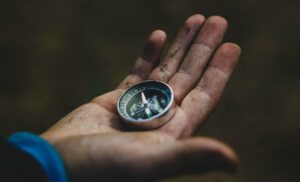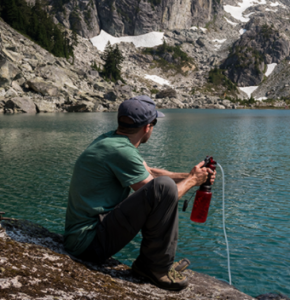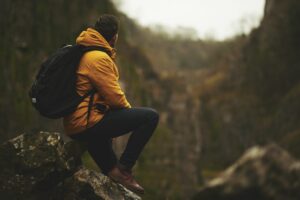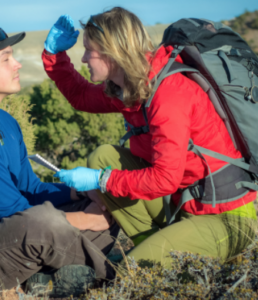In the 1930’s, the Mountaineers, a Seattle-based hiking, climbing, and conservation organization, came up with a list of 10 essential items that no climber should be without in a hike. Hiking is not an activity that should be taken lightly. Any mistake or assumptions made could result in catastrophic or even dire consequences. Especially on more difficult and remote hikes, one needs to follow the listed steps religiously, ensure everything checks out, and setbacks are avoided.
We took the Mountaineer’s list a step further, and took the angle of “what skills are essential for hiking”, many of which require the Mountaineer’s items. We thought it was a fun riff on the concept.
Know How to Use a Map
Maps are an essential part of life whether you realize it or not. In the backcountry, maps take on new importance.
A map not only tells you where you are, how to get to your destination, and how far you have to go, but it can also help you find campsites, water, and an emergency exit route in case of an accident. Fortunately, for today’s hiker, a map can come in many forms. You might have a GPS unit with maps built-in or can use your phone for navigation. Just be sure that you have the maps downloaded because you will often be hiking in areas with little or no cell reception.
Hiking and wilderness maps are different than a normal map, though. They show important details such as waterway navigation or elevation changes, and even campsite locations.
A map will ideally help you better prepare for any unforeseen circumstances that you might find yourself in. It allows you to scout a location before your trip. We all know how important it is to plan before a trip, especially if this is the first time you visit the said location. Being able to use an outdoors map is different than pulling up an app on your phone and plugging in your destination address. Practice, even on easy hikes, using an outdoors map.
Use a Compass Effectively

A compass can help you find your way through unfamiliar terrain—especially in bad weather where you can’t see the landmarks.
Thanks to the technological advances that have been made over the years, travelers can easily access a compass on their smartphones. Aside from that, the devices also come with GPS, which makes it easier for you to make your way through unknown spaces to your desired destination.
Still, being able to use an old-fashioned compass could make the difference of life and death in the right situation. Not trying to be dramatic, but it is true.
Carry Water or Know How to Purify It
When your body goes for long without getting any water, the muscles and the body in general begin to weaken. On top of always being thirsty, you may experience negative health effects. For example, your immune system is compromised, potentially subjecting your body to a number of illnesses including dehydration and even hypothermia.
During the hike, you will use a lot of energy to go up the trail. Therefore, you need a lot of water to ensure that your body remains hydrated and cool. There are several ways to hydrate yourself outdoors, the easiest being to carry water with you as long as it is a shorter excursion. For this, you will need a tough water bottle that is easy to carry and doesn’t leak. 
Additionally, you can always purify water, if you are in an area with streams or lakes. It involves carrying a special device, but one that is easy to use. Why wouldn’t you simply drink straight from the lake or stream? There is a small chance that you will ingest a sickening microbe. If you do, the rest of the hike could be very, very difficult.
Be Able to Fuel Yourself
A couple of things could keep you out longer than expected: a lengthy detour, getting lost, an injury, difficult terrain. A few ounces of extra food will help keep up energy and morale.
Regardless of the length of your hike, always have some hiking snacks along. They can be a real pick-me-up if you find your energy lagging.
If you think you might be on the trail during a major meal time, you can also consider carrying actual freeze-dried meals. These meals have come a long way lately, and can be quite tasty. You will just want to be sure that you are able to boil water and have something to eat with. Nuts, healthy trail mix, and protein bars are also good and easy things to carry in your pack.
Carrying extra food on your hiking trip is worth it. However, be sure to bring non-perishable foods and plenty of water. You can never be too sure when you will get to go back home, and anything might transpire while you are out there in the middle of nowhere.
Be Able to Dress for the Elements
Because the weatherman is not always correct, significantly above treeline, bring along additional layers. Two rules: Avoid cotton (it keeps moisture close to your skin) and always carry a hat.
I have long said that one of the best investments I’ve ever made is a high-end rain shell. I have used it many times, sometimes in really dangerous conditions. The difference between good clothing and so-so clothing is night and day.
and so-so clothing is night and day.
The last thing anyone would want to happen is injuries while in the middle of nowhere. This is where good footwear and protective clothing (like leather gloves if you will be prone to splinters, or to help if you are scrambling) can be incredibly useful. Don’t skimp on your hiking boots, get some good ones.
Protective hiking gear such as boots, hats, and raincoats top this particular list. They will shield you from unfavorable weather conditions. The kit will also help reduce the difficulty that you may encounter during the hike. For instance, hiking shoes help you get a better grip on the ground or wet rocks, preventing you from slipping and injuring yourself.
Know how to Start a Fire!
The warmth of a fire and a hot drink can help prevent an encounter with hypothermia. And fires are a great way to signal for help if you get lost.
You must bring firestarters of some sort with you during any hiking trip, even if you think that you will be done within a short period. You can never plan that far ahead in such a trip. Anything can happen midway. You are better off having carried these necessities and not needing them than not bringing them completely.
I look at it this way: Matches and a piece of firestarter probably weigh 10 ounces and take up next-to-no space. Even if there is only a 3% chance I will need to use it, I carry it.
Furthermore, you can light the fire and use it to prepare meals because you can only go so far on protein bars, snack mix, and berries. For people who are camping, the fire also helps keep predators at bay because animals are startled by fire. This goes for mosquitoes as well — as mosquitoes cannot stand smoke and will stay away from you.
Please note: Fire restrictions are common, especially in late summer and early fall. Please check with the local natural resources agencies or the Forest Service to be sure you are able to use fires during your hike or comping trip. Sometimes there are restrictions against any fire, and other times there are restrictions against campfires but you can still use a fully-contained flame like with a Sierra stove. The rules change based on conditions, so do your own research.
By the way, the best resource we have ever seen on starting a campfire? Definitely this one from Cliff Jacobson. It is 20 minutes long, but such great education for any outdoors person.
Know How to Use a First Aid Kit
Prepackaged first-aid kits for hikers are available at outfitters. Double your effectiveness with knowledge: Take a basic first aid class with the American Red Cross or a Wilderness First Aid class offered by many hiking organizations.
The first aid kit will help you avoid situations from spiraling out of control, especially if one of the members gets hurt while on the hike. Unfortunately, hiking injuries are a thing, and the paramedics could take quite some time before they get to you. It might be difficult for them to maneuver through the trail, for example.
If someone on your hike gets an injury that is not highly severe, you can continue with the hike if you have some basic supplies with you, and know how to use them. We highly recommend doing a quick inventory of your first aid kit before each hike. Take in to account nuances of the local terrain: Are you likely to encounter poison ivy, or mosquitoes? Good things to plan for.
For more serious injuries, being able to dress a wound or at least kill the pain from a fracture can help in the ultimate medical assistance process.
Be Good With an Army Knife or Multi-purpose Tool
Some of the neatest outdoors old-timers I ever knew carried a pocket knife with them, 24/7.
These tools allow you to improvise and cut everything from small pieces of kindling to thistles in your camp area, and everything else. While some people feel like they should carry a big camping saw with them, the fact is that most wood you will use for burning is already broken down an a smaller tool works just fine. A multi-tool can also serve as an important first aid accessory, making cuts the available material to act as bandages. You can also use the tool to repair broken glasses or clasps on gear.
Of course, knives can also be used for cleaning fish or other animals if you are really roughing it and finding your own food. And there is a very rare chance you will actually use the knife for an attacking animal – but probably not. That kind of thing mainly happens in movies.
Understand how to use a knife and the different ways to use one. One single blade can actually be used for many different things if you have the right technique.
Carry a Flashlight and Extra Bulbs

Flashlights (and a few extra bulbs and batteries) will come in handy when it comes to finding your way in the dark and signaling for help. Along with matches, a light is something I never hike without, even if I think I will be hiking during the day.
Of course, they will help you make your way through the trail at night. The extra bulbs will also act as a source of security against predators and intruders in case your current bulbs go out. Also, if you are lost in the middle of nowhere, the search team can use the glowing lights to locate you and bring you back to safety.
Many stories exist of people who set out on a Grand Canyon hike during daylight, only to have to return in the dark on winding and dangerous paths. The answer is to have a flashlight along, or multiple lights! Carry a light, even if you think you will be hiking in the daylight. You just never know what could happen.
Use Sunscreen and Bug Spray
Sunscreen and bug spray can be REALLY important. In many forests, the most dangerous things you will encounter are UV Rays and ticks carrying Lyme disease.
Sunscreen will help shield you from the harmful effects of the hot sun and even the snow. Sunglasses will help prevent snow blindness while the sunscreen will help prevent sunburn.
Bug spray will keep mosquitoes, black flies, and ticks away. Those creatures can be not only annoying, but also dangerous in certain areas as they can carry disease.
Ideally, have sunglasses to provide you with around 90-100% protection against UVA and UVB. Prolonged exposure to the sun’s rays can lead to extensive eye damage and can even cause cataracts.
If you have the above essentials with you on each and every trip, you’re much more likely to have a memorable and smooth hiking trip with fewer or even no hiccups along the way.







